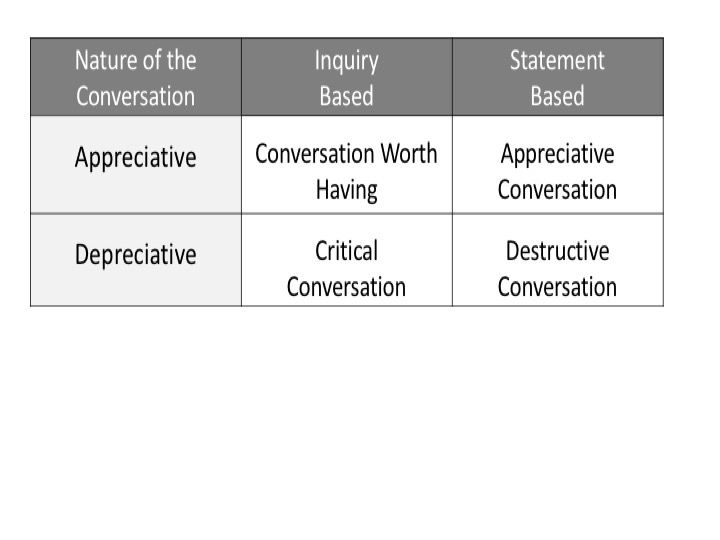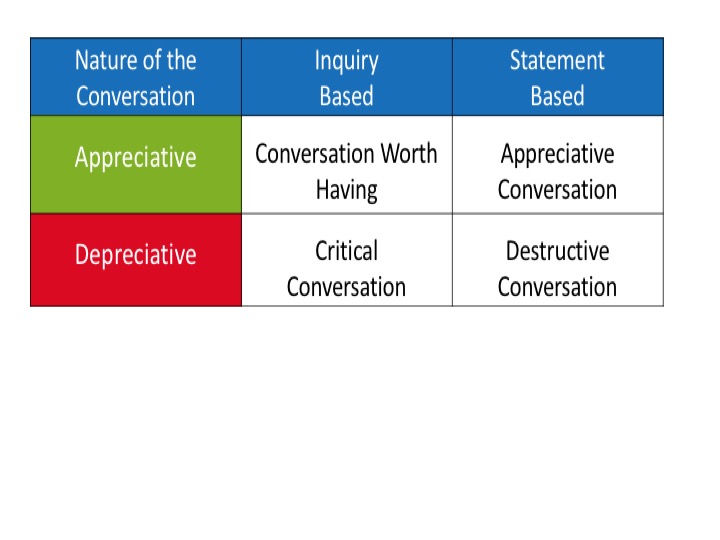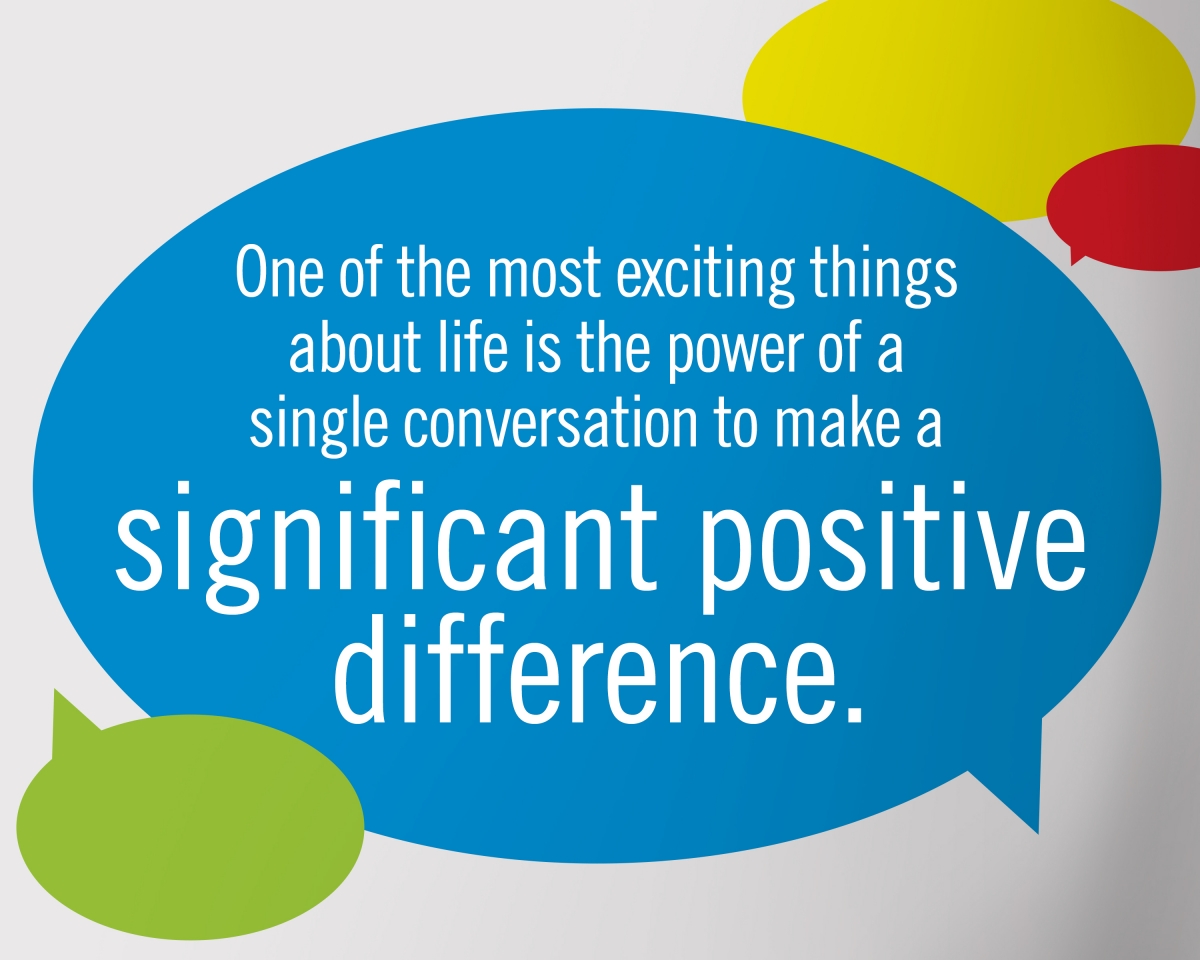Has your organization offered every teambuilding training program you know of to improve teamwork, boost performance, and trigger higher engagement and yet you are still falling short of your goals? Do people come to mandatory trainings now with an attitude of “one more fad to try” and leave sure that nothing will change? If so, it might be time to tune in to the conversations fueling your workplace.
Training and development is successful when people have a high sense of self-efficacy with regard to what they’re learning. In other words, they believe they can make changes and it will make a positive difference. Your training and the conversations you have during training are designed to help people build that sense of self-efficacy. If your training participants are not jaded and disengaged, then the odds are, they leave your trainings pumped up and ready to make the positive changes you’ve exposed them to. They see that value, they may have experienced and applied new ways of being and doing in your training, and they are jazzed. But then…
Take a Listening Tour
If this describes your experience even a little, take time to do a listening tour in your organization. What kind of conversations are learners having once they leave your training, and how are these conversations influencing their self-efficacy? On your tour, listen in a variety of places and to all levels of the system: Conversations among leaders, supervisors and employees, and peers. Pay attention to interactions in the lunch room and around the water cooler or in the hallways. You’re listening to hear the nature of the conversations that are taking place and their impact on people. There are four distinct kinds of conversations (see box below). You’ll recognize them by their content, as well as by the energy of the conversation and the body language of the people involved.

Here’s what to listen for on your tour:
- The tone of the conversation. Is it upbeat, positive, and energetic (appreciative) or is it negative, depleting, and energy draining (depreciative)?
- The direction of the conversation. Are people engaged in possibility thinking and talking about what they do want (appreciative)? Or are they talking about problems and what they don’t like, don’t want, complaining or blaming others (depreciative)?
- The net value-add of the conversation. Are people valuing one another and discussing things that add value to the team or organization (appreciative)? Or are they devaluing people and situations, detracting from what might be possible (depreciative)?
- The intent of the words? Are they asking questions, especially ones for which they have no answers (inquiry based)? Or are they telling and advocating (statement based)? What is the ratio between the questions and statements?
Conversations worth having are
- Appreciative: They add value and value people and situations.
- Inquiry-based: They seek to discover and uncover what might be of value.
Years of positive psychology research tells us that when conversations worth having dominate your culture by 4 to 1, people are primed for implementing change and achieving high- performance work (Stavros, J. and C. Torres. Conversations Worth Having: Using Appreciative Inquiry to Fuel Productive and Meaningful Engagement. San Francisco: Berrett Koehler Publishers, 2018.). This is completely logical when you realize how our brains and nervous systems function.
How Conversations Influence Training ROI
As a biological being, survival is primary, and for humans this includes belonging. Our primal brain (think fight, flight, freeze, or appease) is always scanning to ensure our safety. Any threat to survival or belonging sends oxygen and fuel to the primal brain, starving our prefrontal cortex (home to critical thinking, creativity, connection, and trust). Knowing this, it is easy to see why critical and destructive conversations—which threaten our sense of belonging and survival—lower self-efficacy, performance, and teamwork (Glaser, J. Conversational Intelligence: How Great Leaders Build Trust and Get Extraordinary Results.NY: Bibliomotion, Inc., 2014). On the other hand, conversations worth having signal belonging and safety. This triggers the release of “feel good” hormones (oxytocin, dopamine, serotonin, and endorphins) into our nervous systems, priming our brains for creativity, connection, and higher-order thinking. This neurophysiological state is what supports our ability to change and to engage in high performance with others. Knowing this, it is easy to see how critical our conversations are to the successful implementation of team training.
3 Steps to Improve ROI for Training
If you have discovered that conversations in your organization fall below the 4-to-1 ratio of appreciative to depreciative conversations, here is a set of practices you can add to your training to improve the chances of implementation. Let your participants know how important their conversations are to their capacity to act on the training. Encourage them to follow these three steps to have conversations worth having (Op. Cit., Stavros and Torres):
-
PAUSE before speaking. Where’s your brain? If your primal brain is activated, don’t talk until you’ve shifted. Otherwise, you’ll be speaking from a place of fear and distrust, and it likely will lead to a depreciative conversation. Instead, breathe and take in AIR (Adapted from Maureen McKenna’s AIR model, Energizing Conversations@Work. Available on http://www.returnonenergy.ca):
- Appreciate: Yourself, others who are present, and the broader context of the situation and the conversation. Assume positive intent and take in the bigger picture. Breathe.
- Inquire: Ask yourself questions that generate possibility, curiosity, connection, and opening. These questions should engender curiosity about what you don’t know and what you might be making up. For example: What’s really going on here for me? For others? What conclusions have I jumped to? How might we make what’s invisible visible? Breathe.
- Reflect: What is your higher intention for this conversation and what impact do you want to have? Breathe.
-
Positive Framing. Create a positive frame for the conversation. This means intentionally shaping the conversation to focus on a desirable outcome, to focus on what you and others want. This should not be mistaken for focusing only on the positive. Quite the contrary, this is about dealing with even the toughest issues in a way that motivates everyone to find creative solutions and take action. Your participants can use a tool called Flipping, which helps them move from a negative, deficit-based frame to a positive frame:
- Name It. What is the problem, complaint, or the thing you don’t want?
- Flip It. What is the positive opposite, the thing you do want?
- Frame It. What is the positive impact if the flip is true; what is the desired outcome?

- Generative Questions.Encourage them to stay curious and continue to ask generative questions openly in their conversations. When dealing with any issue, even difficult issues, generative questions make unseen information visible and result in conversations that create trust, positive energy, and the transformative power to move the team forward in a desired direction. The result: new ways for teams to work together take root.
Here are some examples of generative questions:
- Make room for diverse and different perspectives: How do you see this training playing out for our team?
- Surface new information and knowledge: How did they manage this process at your previous plant? What was your experience like? What worked for you?
- Stimulate creativity and innovation: What might be possible if we actually implemented the materials in this training?
- Focus on the best of what is and what might be: Tell me a time when implementing change worked really well for you. When have we engaged in this way in the past?
- Deepen connections—engages those on the sidelines: How do you see it? What is important to you about this training?
- Generate understanding and strengthen relationships: Can you say more about what you are thinking? Help me understand your perspective? Are you saying…?
- Allow strengths to showup: How might each of us contribute to the success of this venture? How are we already reflecting these changes?
- Make wishes come true: What are three wishes you have for taking this training forward and making it worth our time and resources?

Conversations inform everything we do. If you want your trainings to have greater impact, teach your participants to have conversations worth having, especially about the information they are learning and the practical implementation of those ideas. They will improve their ROI for your training and they have the power to transform their team culture!
Cheri B. Torres, Ph.D., is a senior consultant with NextMove.is (http://www.nextmove.is) and partner at Innovation Partners International. Working with Torres, people learn to use everyday conversation to dramatically improve outcomes for their organization and relationships. Leaders and team members develop their capacity to use Appreciative Inquiry to foster productive and meaningful engagement, even when facing complex problems. Torres has authored or co-authored numerous books and articles; her most recent, “Conversations Worth Having: Using Appreciative Inquiry to Fuel Productive and Meaningful Engagement,” is available now and will have an accompanying training program. For more information, visit: conversationsworthhaving.today.




